In March, there’s something coming to Needle ‘n Thread that I’m very excited about! Thanks to Mike up in Canada, I’ll be adding a new element to the free embroidery patterns offered here. These new patterns will feature formerly unpublished patterns from a Hungarian lady – a professional embroiderer and artist – with an interesting history. I’m excited to provide them to you for several reasons: 1. I think it’s important to keep alive the interest in folk embroidery from various regions of the world, and Hungary has a very rich tradition of colorful folk (and fine) embroidery; 2. the patterns can be easily adapted to other embroidery styles, such as Schwalm whitework techniques and so forth; and 3. the patterns are just really beautiful!
So as the time creeps closer to presenting those patterns, I want to highlight some books that I have in my collection that feature folk embroidery from different regions. I’ve already touched on one book – Nagyanyáink öröksege – which illustrates the variety of color and styles in Hungarian embroidery.
The book I want to show you today is called Korai Kalocsai Hímzések, or Early Kolocsa Embroideries. It’s essentially a pattern book, excellent for embroiderers looking for patterns to use on tablecloths, household items, and costumes, and the individual motifs would serve well for adapting to all kinds of needlework projects.
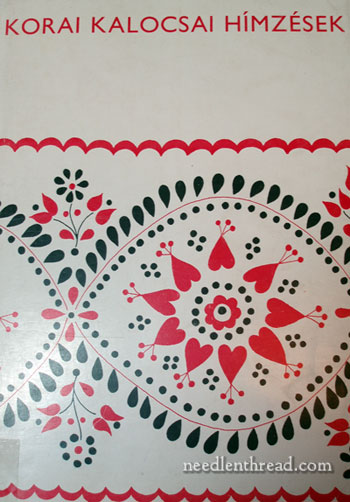
The books is a very simple publication. It is not packed with color, and it has no photos of finished embroideries. But the patterns that are packed between its pages make up for any perceived shortcomings!
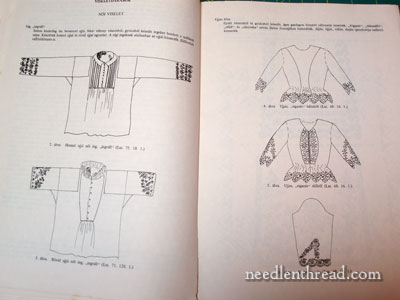
While the text of the book is Hungarian, in fact, there is very little text – just a little sprinkling at the beginning of the book, explaining the different elements of traditional Hungarian costume and household goods.
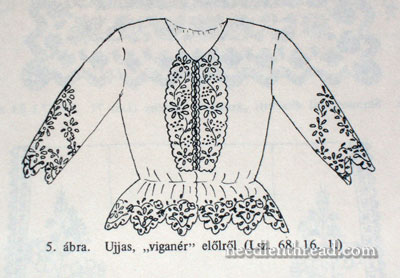
For anyone interested in traditional costumes, the line drawings of blouses, shirts, aprons, and so forth, would be of interest, I would think.
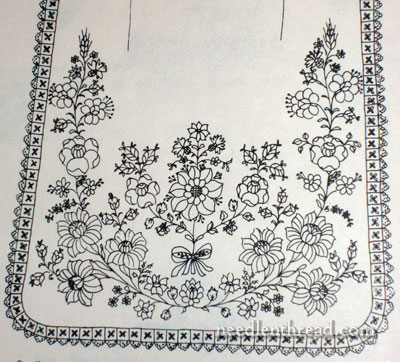
I love the line drawing of this apron! Even though it’s black and white, it’s not hard to imagine the blazing colors that would embellish the thing. And I can’t help contemplating the amount of care and time that went into creating various elements of traditional regional costumes!
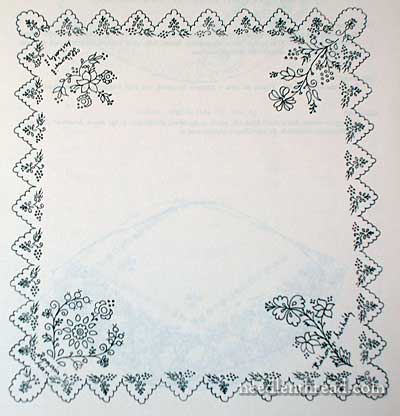
There are also line drawings that show the layout of embroidered tablecloths…
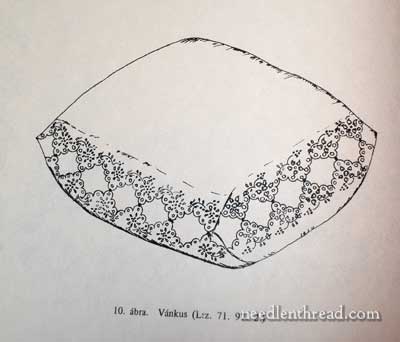
… and embroidered pillowcases…
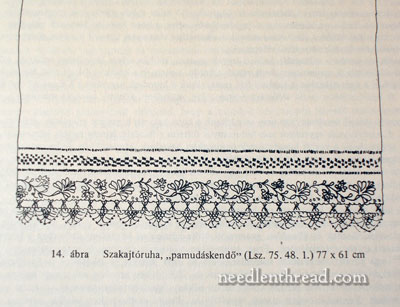
… and embroidered scarves or table runners.
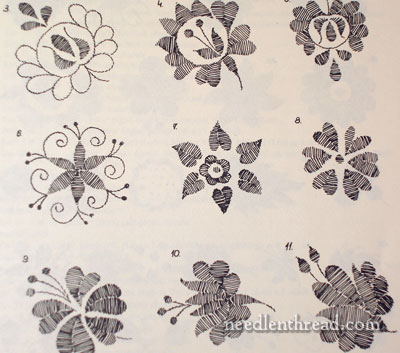
The book does not demonstrate visually any stitching techniques. If there are instructions on stitches, they correspond with these motifs. But I am not certain if they are actually instructions, as I don’t read Hungarian. But what these motifs do demonstrate very well visually is stitching direction. In a style of embroidery where elements are often boldly and heavily filled, it is good to know the prescribed direction in which the stitches should be worked.
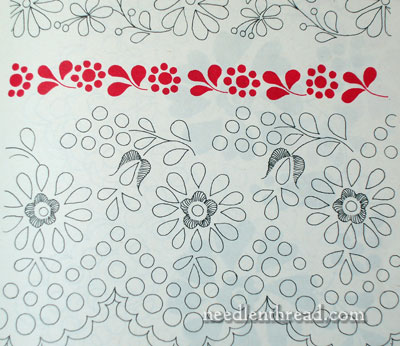
Here and there on the pattern pages throughout the rest of the book (the bulk of the book is page after page after page of patterns – some pages unfolding into larger pages) there are splashes of bold color, but most of the patterns are presented either as line drawings or as filled drawings, filled with either red (as in the photo above), blue, black, or sometimes a combination.
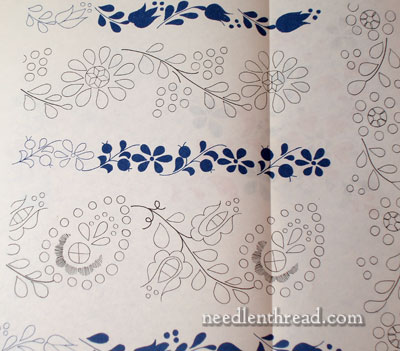
Here’s part of one of the fold-out pages, packed with a variety of border patterns.
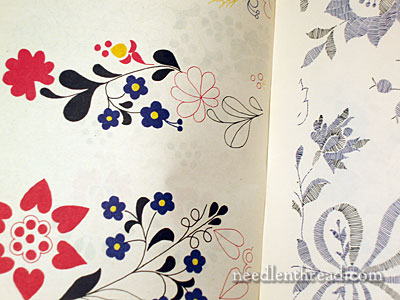
And here are a few patterns printed in bright colors that imitate the bright colors found in Hungarian folk embroidery.
This book is a real gem for anyone interested in patterns, and even if you aren’t keen on the more “rustic” colorful folk embroidery, the patterns herein are equally adaptable to all kinds of needlework. Hungarian needlework, by the way, is not all “folk” needlework. There are some exquisite examples of very fine whitework from Hungary in many of the books on the subject. So the patterns, while they seem simple, are perfectly suitable for complex techniques.
Now, the disappointing thing is that this book is a bit older, and it is out of print, so it’s somewhat hard to find. However, thorough searching of the title (in Hungarian) at used book sources may turn up a few copies available here and there.
I’m looking forward to sharing some Hungarian patterns with you this year, hopefully starting in March. I hope they inspire an interest in the folk embroidery of other regions of the world – helping, perhaps, to renew an interest in these techniques and to keep them alive for future generations of needleworkers.
By the way, when you look at the patterns above, can you see other uses for them, besides needlework? I was thinking appliqué, paper cutting… Can you think of others? Leave a comment and let us know what you think!
Have a swell Friday – and a smashing weekend with your needle and thread!







I haven’t got too much free time, but if you are interested, perhaps I can help with some short translating from Hungarian to English. 🙂
Thanks, KerGiz!! I appreciate that! If I come across something I absolutely have to know, I’ll be in touch! ~Mary
My father was born in Budapest but I know nothing more.
Sad that none of the crafts made it through from Hungary or Lithuania (my mom).
Nice to see. Thank you, Mary.
Those designs are beautiful and I love to see how designs have developed from different regions. Thanks Mary. I am excited too!
This is great! I love Russian and Ukrainian cross-stitch, and have dabbled a bit in both. I’d like to expand into Polish and Hungarian needlework. I’m really excited to see the patterns you’re getting ready to share.
These patterns could certainly be used to make pysanki – dyed Easter eggs.
Oh my goodness, I’m so excited. I love Hungarian embroidery.
I had a professor from Hungary. Some years ago he went for a visit and brought me back a beautiful embroidered table runner. He said the ladies would sit in the park and embroider. I hope one day to be able to do as beautiful a job as they did.
That is great. It looks like there are a lot of pattern for broderie Anglaise which are fantastic. I’ll try to get this book. Thank you.
This book has some nice designs. I’m of mixed thoughts on books like this, photos vs. line drawings that is.
On one hand, the line drawings make you to use your imagination on what the finished product would be like. You have to make your own plan regarding technique, stitches, colors, materials.
On the other hand, I do miss seeing the final results as traditionally done. But I will admit that when I see photos of the finished project, I tend to think that’s what mine should look like. If I saw these done in embroidery, I’d most likely not consider how they would be in beads/sequins.
Some of these would also be wonderful stencils for walls, furniture, fabric. Also as inspiration for freehand painting. How about carving them into wood?
Oh Mary! I can’t tell you how excited I am about this! I went to Hungary for a month about 13 years ago and left my heart there! I managed to buy a few pieces of linens and pottery and now collect them as I can. I’ve recently taken up embroidery and I would LOVE to give the Hungarian kolocsa a shot! Thank you thank you thank you!!!
Hi, All – Thanks very much for your comments!
I’m glad you’re all excited about this, too.
Christina – Incidentally, I had a professor from Hungary, too. She taught me Latin!
Gail – wood carving is a great idea!
MIKE – if you read this, I keep trying to send you e-mails, but they keep bouncing back. I’m receiving yours ok, but can’t seem to get mine through to you! I’m not exactly sure how else to get in touch with you, so I’ve got my fingers crossed that you’ll check back in on the comments here!
Thanks again, everyone, for your enthused response!
MC
That apron pattern is absolutely stunning!! I would definitely want to stick with the black and white – on a crazy quilt piece perhaps.
My seminary roomate is Hungarian and I can see using these designs in a quilt not only for the appliques, but the outlines for the quilting as well as adding some embroidered blocks to the project. I may even design her ordination stoles, with a mix of Hungarian and my own designs which would be fitting for her journey. Better yet, I’m going to send her or her mom on a shopping trip to their local craft store to see what might be available there. I don’t read Hungarian either, but I will figure it out.
stencilling for pictures in black white designs also
stencilling for pictures could be an idea for some of
the designs
Oh Mary, this is just wonderful! Thank you so much!!!!
OH!!! I LOVE these designs!!! I now must find that book. I can so see this done in applique. Or painted/stenciled on furniture… too pretty!
I just discovered and joined this site and am excited to read today that you will have Hungarian embroidery on the site. I am of Hungarian heritage and I would love to see and do sew some. I will pass this along to a friend who is Hungarian decent also. Thank you. Betty
Wow! I want to stitch these designs! But I also want to use them as a resource for stencils, stamps and thermofax screens! Thanks for the inspiration! Also need to tell you I got some samples of wonderful red felt from a place called Weir Craft. Lovely wool thats nice and thick. Email me if you want the info!
co
Dear Mary,
Hungarian embroidery speaks to my heart and I’m so glad you have plans to explore it.
It is my very close heritage as I was born there and lived in Budapest for most of my young adult life, now here in the US for many years.
All the women in my family were experienced in many type of needlework, so I owe them for all the foundation and inspiration I have for the love of needle and thread.
Hungarian embroidery is very varied and each geographic area have their own style. Some are very colorful, some are all white, some use only two or three colors and very different stitching styles.
One time my Father took me to one of his client’s home somewhere way outside of Budapest, and the lady of the house showed me around their home which was decorated in all the old traditional Hungarian folk style.
To see their bedroom was an absolute feast for the eyes. All the bedding, curtains, small tables were covered with intricately embroidered linens and the colorful styles were mixed with pure white embroideries.
The furniture and walls were decorated using some of the same type of designs what you have posted here.
Also filled with beautiful hand painted potteries.
I was stunned to see all the beautiful handwork, and having done some myself I still only could imagine how much time it took to create all of it.
I’m sure some were handed down through the generations and truly treasured. I wish now I have asked more questions about them.
Like most of us here I love needlework books of all kind and I have several Hungarian books in my collection.
A couple I can not reach right now, but one of my favorite on is:
“Nepi Kezimunkak” by Lengyel Gyorgyi
Great color illustrations and photos
http://madsamplarbooks.com/Nepi_kezimunkak.htm
This is a folk art store (in English)
Lots of good info here on the history.
http://www.folk-art-hungary.com/
An other store with lots of pretty samples.
http://www.hungarianfolkart.com/embroidery.html
The national folk costume is an other site to behold.
Here you can have a taste of the home I wrote about … similar and also embroidered costumes
http://historicaltextarchive.com/hungary/costumes.html
http://hungaria.org/projects.php?projectid=4&menuid=194
And I could go on and on … but I just had to share.
Also Mary … I would be happy to help with translation if you need it.
On the websites I have a way of clicking on the Google menu button and “Translate”. Most of the time it comes pretty close to the real thing 🙂
I’m sure you have it on your browser as well.
I’m so looking forward to your postings on this subject!
Suzanna
Thank you, Suzanna! I loved reading your comment, and looking at the links. Actually, I have that first book – there’s a review of it on here somewhere. I think I linked to it in the post above. It’s a great book – love the color! I’m looking forward to posting a bit more about the subject, too, in the upcoming days! Regional embroidery styles have been area in which I’ve steadily become more and more interested over the years!
~MC
Thanks Mary for the info about Hungarian embroidery as I’ll be visiting Budapest over Easter.
Nora
OMG! I can’t wait!!! This is the true meaning behind my reason for learning embroidery!!! Thank you!
What lovely images, I enjoy embroidery, but also a lot of paper crafts too.
I took inspiration from these images to do some paper quilling — I hope you like it.
http://blog.craftandsmile.com/2011/02/25/cross-crafting/
I will look for it, and see if my husband can translate for me.
I have a tablecloth and apron at home which I am working on. The detail is incredible.
Thank you.
Wow, what a treasure to see. Is there anyone who can translate out there? Thanks, Betty
Hello,
I m hungarian. I was born and living in Hungary. I’ ve learned hungarian folk embroidery and lace making. Here are so many style in several side of the country.
This book is one of them, from Kalocsa, what is a town in the middle of Hungary. It s so nice to see, that you like our folk arts! Thank you!
You can see some of them what I ve created on my blog: http://csipke-csoda.blogspot.com/2011_02_01_archive.html
I wanted to thanks you for showcasing these two books and the artist Lilly in your website. I an of Hungarian heritage on my mother’s side but do not know that much about the hand crafts and found these postings very interesting and fun to read. The patterns are delightful and I plan to use on some kitchen linens. I have a few pieces of my grandmothers, mostly crochet and tatting doilies. but also some dishtowels and handkerchiefs. The towels and hankies were ones that she exchanged with her pen pals and friends and a couple have similiar designs to some of those in the first book.
I lived and taught English in Kalosca for a year after college in the US. Oh how I wish I would have embroidered with someone there! What a wonderful offering! Their work is so very beautiful! I am so glad the tradition is being kept alive!
Hi, Mary.
I am Edna, from Brasil. I like your all you r craft. I downloaded many books trhough your site, thank you.
Bye
Edna
Thanks for asking!
I would use some of these wonderful patterns for the basis of Native American style bead embroidery. After adapting the pattern and transferring it to the leather or fabric of my garment, I’d bead-embroider directly to the garment.
I might chart one of my favorites, and bead it on a loom–the resulting strips or fabric to be appliqued to textile fabric or to leather of my garment.
Not certain about that last bit … But who knows? :~)
Blessings
Doree
§ :~D)>o
Thank you for sharing these folk patterns. I’m looking to apply them on leather, like they were done on their sheepskin coats. It has been almost impossible to find ‘how to’ books, pamphlets, any printed information on the topic. I have ONE book this far, and been looking for months. The title is ‘The art of the Hungarian furrier’. Colorful pictures, but lacks instructions. Please help , thank you!
Hi ! I’ve just started my first Hungarian embroidery. I was fascinated by it when I was in Hungary in 2015 & 2016 again. The piece I’m doing is a tea towel but I plan to frame the embroidery for my Hungarian corner in my home ! While it’s not very good, it’s not so bad either. Hopefully will get the hang of it soon. Am looking forward to doing More in the future…!
I just love these patterns, and would love to try to make them using my sewing machine! Can you please advise me of where I can purchase these patterns. I thank you in advance for any assistance you can provide.
Susan
Dear Ms Corbet,
Hello Ms Corbet, this is a South Korean student, investigating the traditional Hungarian embroidery in an international school. I would have to show a great appreciation for your dedication to the research of needle works, especially Hungarian embroideries since two of your posts were a great help to me in getting to know more about the art form. I wondered if you still write more about needlework, and I am glad that the archives have been being filled out for so many years! I’m in grade 8 now, almost G9, and I am so surprised by the consistent hard work from nearly the years when I was born. Thank you again, and I cheer to your records about needle works.
Best regards, Catherine
🙂 Thank you, Catherine! What a wonderful area of study that you are working in! I wish you the best of luck!